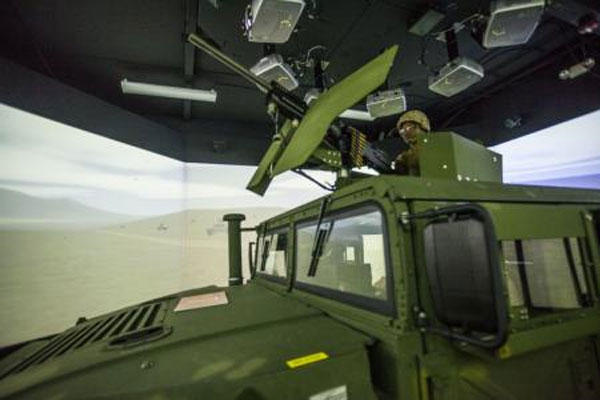CAMP PENDLETON, Calif. - In accordance with a weeklong deployment for training exercise, the Marines and Sailors with Headquarters and Headquarters Squadron, based out of Marine Corps Air Station Yuma, Ariz., took part in combat convoy simulator training at the Tactical Vehicle Simulation Center at Marine Corps Base Camp Pendleton, Calif., May 16.
Training in teams of up to five, the Marines took to the $10 million high mobility multipurpose wheeled vehicle simulators with anticipation and a willingness to hone the interactive combat skills that were taught throughout the annual squadron exercise.
"They'll be going over the functions of the weapons systems, the capabilities of the software, the real basics of how this works," said Sgt. Matthew Jonathan Hart, a combat convoy simulator instructor, infantry squad leader based out of Camp Pendleton, Calif., and a native of Bothell, Wash. "I just hope they get to understand the basics of convoy operations - I know this is something they're not particularly used to, so this is a really good introduction to it."
Learning how to work well as a unit and being able to communicate with each other in the separate vehicles were priority objectives on the board for the 42 participating Marines.
The simulators themselves are contained in a dark room, surrounded by walls and overhead projectors that deliver a 360 degree virtual reality view of desert terrain akin to Iraq and Afghanistan on the simulator walls. Despite being housed in separate rooms, the high-tech system manages to tie every HMMWV simulator together for the Marines to take part in multi-user, real time convoy scenarios.
"We're getting a virtual view of what a patrol would be like over in Afghanistan and Iraq, so I would say they've done a really good job portraying what it would look like over there," said Cpl. Jon Kovalsky, a H&HS administrative specialist and a native of Atlanta, Ga. "The holograms were very precise. The HMMWV - They had all the weapons hooked up to it; from the .50 cal. on the turret to the M16's - everything was pretty legit."
Practicing the capacity to call in the appropriate commands and not crack under the pressure of an insurgent attack is crucial to unit cohesion. For the H&HS Marines, several communication challenges presented themselves during the training; not the least of which was learning how to operate the radios and understanding convoy positioning.
"I think the biggest thing to work on was just how to execute the IA (Immediate Action) drills," said Hart. "How the convoy commander briefed it and just understanding the convoy commanders intent and being able to execute off of that. What they want to do in the end is what needs to happen and the small unit leaders need to take that and execute."
For two separate hour long sessions, the Marines took to their vehicles in the convoy and switched roles to better understand the workings of a patrol. From manning the turret to driving to supplemental security, everyone took something to learn away with them.
"Sweeping areas, getting in the right formations, we were kind of getting use to it the first go around,” added Kovalsky. “But I feel like we did a pretty good job."
The center is a great site to facilitate units which have limited vehicle assets available. Experienced, helpful instructors and a cost-efficient means of training in a technologically sophisticated and highly advanced system is a testament to the Corps still being at the forefront of training for tomorrow, today.


























